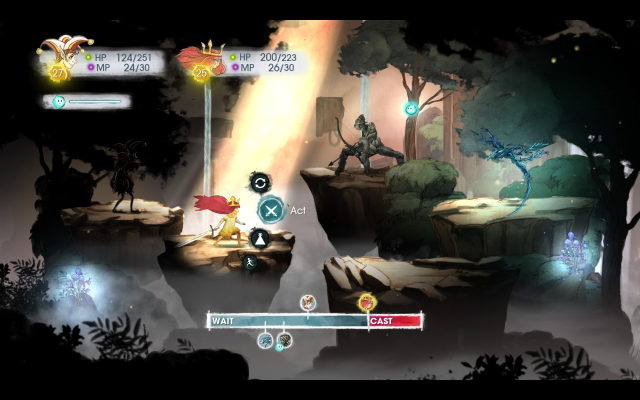Grandia 2 Anniversary Edition is out today on Steam and GOG. Hooray! This is the best combat system in JRPG history, bar none, now available without the questionable English voice acting. Grandia’s combat is much beloved among JRPG enthusiasts, so much so that in the absence of any official sequel from GameArts since 2005, multiple developers have decided to take its fundamental mechanics and build new RPGs around them. This is a look at a few of them and how, while they are great games in their own right, there is no comparison with the original.
Child of Light comes from Ubisoft and is built on the 2D engine used in their modern Rayman games, which finally justifies the existence of that series. A very, very barebones RPG with stunning art, Child of Light’s combat focuses exclusively on Grandia’s central idea of interrupting enemy actions. There is a timeline showing how close each character and enemy is to acting. There is a delay between selecting an action and executing it. If a character/enemy is attacked during that delay, their turn is cancelled and they are thrown back to near the start of the timeline. That’s all there is to it, and it’s enough to deliver a satisfying 15-hour game.

Do I have time for the slow powerful spell that will make the next 5 turns much easier, or will the enemy choose a quick attack that interrupts me? Do I have time to interrupt the enemy’s attack, or should I play it safe and defend? Even in normal encounters you’re faced with interesting choices on a regular basis. The timeline being continuous rather than discrete means the possibility space is effectively infinite, and a slight bit of randomization at the beginning of combat keeps can result in a totally different series of choices to make by the time five or six turns have elapsed.
Jumping back a few years, Zeboyd’s two sequels to Penny Arcade’s On The Rainslick Precipice Of Darkness were the first in the wave of Grandialikes, and while they also streamline and simplify, they preserve a few more of Grandia’s wrinkles. In Child of Light, every attack is capable of interrupting; in Grandia and RSPD, only specific types of attack have this property, and generally speaking you give something up to get that advantage, usually damage. In fact, the most inexpensive interrupting abilities in RSPD do no damage at all. Now the question is not just whether you can beat the enemy to the end of the timeline, but also whether it’s in your interest to sacrifice an attack to cancel theirs, or simply trade damage.
The extent to which you can take advantage of interrupts also depends on your party configuration, and in that area RSPD 3 and 4 borrow heavily from Final Fantasies 5 and 6 respectively. Certain jobs/classes/whatever are more adept at interrupts than others, you can spend an equipment slot on an accessory that gives all your attacks the interrupt property, etc. The situational usefulness of interrupts is brought more to the forefront in RSPD compared to Child of Light.
What sets Grandia apart from these worthy imitators is its use of space in coordination with time. Grandia is about as far removed as you can get from the Final Fantasy model where the party and the monsters are lined up on opposite sides of the screen and step forward one at a time to throw a punch. In Grandia, everyone is running around in a frenzy, all the time – and this has real consequences for gameplay! Melee attacks don’t just happen when the character reaches the end of the timeline; they have to run over to the target, and they’re still vulnerable to interrupts during that time. In fact, in the video above, you can actually see an enemy combo’d to death while attempting to reach its target – an entirely different solution to the interrupt problem. Now in addition to all the other mental math you’ve been doing – am I far enough ahead on the timeline? Is the damage I’m preventing to myself worth the damage I’m not dealing to them? – you must factor in your distance from every enemy on the battlefield and how quickly you can cross it.
Although there is a lot of automatic running around (which does as much to keep battles lively as the butt-kickin’ soundtrack) you can use a turn to move manually as well. This lets you not only set up cancels on the next turn, but also avoid bunching your party up where a single area-of-effect spell can hit them all. And need I tell you what a difference it makes when you gain a character whose cancel attack is ranged? Movement hugely expands the possibility space beyond what Child of Light and RSPD can offer – and since Grandia 2 is a full size 2000-era RPG with a 40-hour storyline, it needs to.
Most of all, what the combination of movement and timing accomplishes is to make what is still fundamentally a turn-based game feel as exciting and visceral as an action game. Running across the map to land a cancel with a fraction of a second to spare feels like scoring a touchdown. Compared to Active Time Battle, which also attempted to liven up turn-based battle, but – well, you know how I feel by now – Grandia not only succeeds but does so while still giving the player time to agonize over those close calls.
Unfortunately, after Grandia 2 there was nowhere to go but down for GameArts; Grandia Xtreme and Grandia 3 gave us more of the same great combat, but with the trite anime teen dialogue becoming increasingly hard to swallow. After they were purchased by mobile giant GungHo it seemed like that would be the end of the story, but with the surprising re-release of Grandia 2 – and the announcement of Star Ocean 5 for consoles by the similarly-positioned studio tri-Ace – perhaps there is still a chance for GameArts to surpass themselves.
